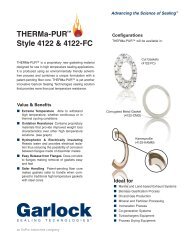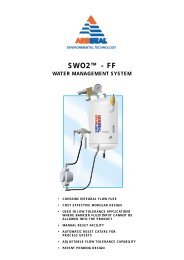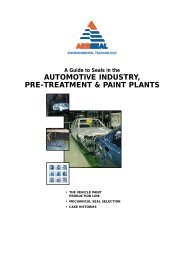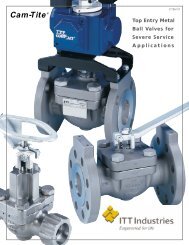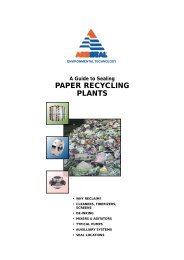expansion joints - AR Thomson Group
expansion joints - AR Thomson Group
expansion joints - AR Thomson Group
You also want an ePaper? Increase the reach of your titles
YUMPU automatically turns print PDFs into web optimized ePapers that Google loves.
ELASTOMERIC EXPANSION JOINTS<br />
Definition and Function<br />
1. Flexible Connector - An elastomeric <strong>expansion</strong> joint<br />
is a specially designed section of pipe inserted within<br />
a rigid piping system to provide flexibility.<br />
2. Stress Relief - Pipe stress caused by thermal<br />
<strong>expansion</strong>/contraction or foundation settlement can<br />
be handled by <strong>expansion</strong> <strong>joints</strong>.<br />
3. Minor Misalignment - Standard <strong>expansion</strong> <strong>joints</strong><br />
can withstand a minimal amount of existing lateral,<br />
torsional, angular or concurrent misalignment.<br />
Contact the manufacturer for specifics.<br />
4. Isolate/Reduce Vibration - Oscillating movement<br />
around the axis of the <strong>expansion</strong> joint can be effectively<br />
dampened, eliminating the transmission of<br />
this vibration - preventing equipment damage/failure.<br />
5. Dampen Sound Transmission - Using rubber<br />
flanges, <strong>expansion</strong> <strong>joints</strong> can lower the transmission<br />
of undesirable noises.<br />
6. Multiple Arch Type - Expansion <strong>joints</strong> with up to<br />
four arches may be manufactured to handle greater<br />
movements than a single arch. The movement capability<br />
of a multiple arch <strong>expansion</strong> joint is typically<br />
that of a single arch type multiplied by the number of<br />
arches. (See Figures 1, 2 & Table I)<br />
Construction Details<br />
Elastomeric <strong>expansion</strong> <strong>joints</strong> are constructed of three<br />
basic elements: the tube, the body or carcass, and the<br />
cover. The construction details are shown in Figures 1-4<br />
and each element is defined as follows:<br />
1. Tube - Consists of a protective, leakproof lining<br />
which may be made of synthetic or natural rubber,<br />
depending on operating conditions. The tube is<br />
seamless and it extends through the bore of the<br />
joint to the outside edges of the flanges. Its purpose<br />
is to eliminate the possibility of the materials being<br />
handled from penetrating the carcass and weakening<br />
the fabric. Tubes can be designed to handle a wide<br />
range of service conditions for chemical, petroleum,<br />
sewage, gaseous, and abrasive materials. When<br />
evaluating a specific application, the media will<br />
7. Natural/Synthetic Elastomer - A wide variety of<br />
elastomers are available to meet specific demands<br />
of industrial applications.<br />
8. Fabric/Metal Reinforced - The strength in an<br />
elastomeric <strong>expansion</strong> joint is derived from design<br />
features, combined with rubber impregnated layers<br />
of fabric and internal metal reinforcement. (See<br />
Figures 1 & 2)<br />
9. Fabric Reinforcement - In these styles, wide flowing<br />
arch (Figure 3) and U-type (Figure 4), fabric is<br />
used to effectively handle design parameters outlined.<br />
10. Resistance To Corrosive Media - Special elastomeric<br />
liners and covers may be utilized to prolong<br />
life of the <strong>expansion</strong> joint when corrosives are<br />
present.<br />
11. Resistance To Abrasive Media - Abrasive media<br />
may be handled more effectively if a special<br />
tube/liner is used; ie: gum rubber, increasing thick<br />
ness of layers (rubber), steel flow liner, etc.<br />
12. Temperature Capability - Depending on the elastomer<br />
selected, elastomeric <strong>expansion</strong> <strong>joints</strong> can<br />
handle a range of -40°F (-40°C) to 400°F (205°C).<br />
dictate the type of elastomer needed; ie:<br />
fluoroelastomer (VITON ® ), FEP fluorocarbon, nitrile,<br />
EPDM, HYPALON ® , chlorobutyl, gum rubber, or<br />
neoprene elastomers are frequently specified.<br />
FDA- approved materials such as white neoprene<br />
or white EPDM elastomers are also available.<br />
2. Body or Carcass - Consists of fabric/metal<br />
reinforcement. Expansion <strong>joints</strong> with a combination<br />
of fabric and metal reinforcement are shown in<br />
Figures 1 & 2. The <strong>expansion</strong> <strong>joints</strong> in Figures 3 &<br />
4 have fabric reinforcement only.<br />
VITON and HYPALON are registered trademarks of DuPont Dow<br />
Elastomers.<br />
1



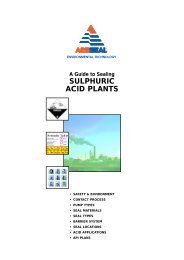
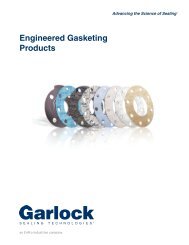
![VCS Flange Gasket [1.03 MB] - AR Thomson Group](https://img.yumpu.com/12044617/1/190x245/vcs-flange-gasket-103-mb-ar-thomson-group.jpg?quality=85)

![PGE Flange Gasket Product Brochure [1.04 MB] - AR Thomson Group](https://img.yumpu.com/12044595/1/190x245/pge-flange-gasket-product-brochure-104-mb-ar-thomson-group.jpg?quality=85)
